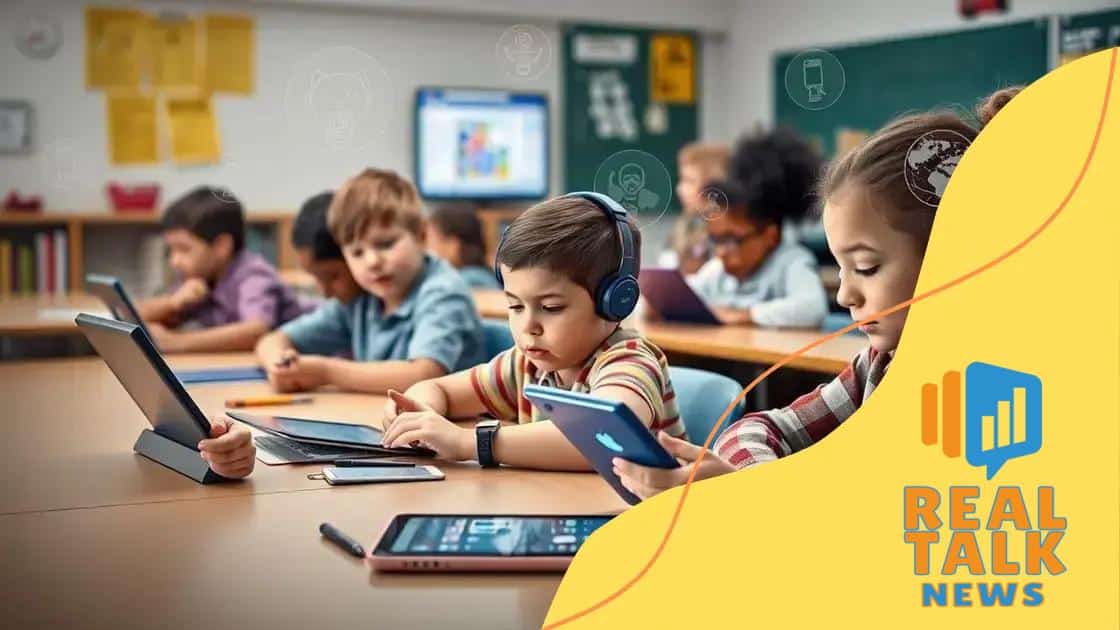The role of AI in supporting students with learning disabilities

The role of AI in supporting students with learning disabilities includes personalized learning experiences, adaptive tools, and accessible resources that improve engagement and academic success.
The role of AI in supporting students with learning disabilities is a game-changer in modern education. Have you ever wondered how technology reshapes the way students learn? Let’s dive into this fascinating topic.
Understanding learning disabilities and their challenges
Understanding learning disabilities is crucial to help students succeed in the classroom. These disabilities can affect how individuals process information, which can lead to difficulties in areas such as reading, writing, and math. Recognizing these challenges allows educators and parents to provide better support.
Common Types of Learning Disabilities
There are several types of learning disabilities that can impact a student’s educational experience. Each type presents unique challenges, and understanding them is the first step toward effective intervention.
- Dyslexia: Affects reading skills, often leading to difficulties in decoding words.
- Dysgraphia: Impacts writing abilities and fine motor skills, making writing tasks challenging.
- Dyscalculia: Affects math skills, making it hard to comprehend numbers and math concepts.
- Executive Function Disorders: Struggle with organization, time management, and focus.
These disabilities can manifest differently in each student, which is why tailored approaches are necessary. Some students may excel in verbal skills but struggle with written tasks, while others may have difficulty following multi-step instructions. Recognizing these patterns helps teachers design appropriate interventions.
In addition to academic challenges, students with learning disabilities may also face social and emotional hurdles. They might feel frustrated, anxious, or isolated, which can further impact their performance in school. It is essential to create a supportive environment that encourages their strengths while addressing their weaknesses.
Importance of Early Identification
Early identification of learning disabilities can significantly improve outcomes for students. The sooner a disability is recognized, the earlier appropriate strategies can be implemented. This will not only enhance academic performance but also boost the student’s confidence.
Schools should implement regular assessments and provide resources for teachers to help identify students who may be struggling. Collaboration between teachers, parents, and specialists ensures that students receive the comprehensive support they need to thrive.
In conclusion, understanding learning disabilities and their challenges is vital for creating an effective educational environment. By recognizing the individual needs of students, we can help them achieve their full potential.
How AI personalizes learning experiences for students
AI plays a pivotal role in how we can personalize learning experiences for students, especially those with learning disabilities. By utilizing technology, educators can cater to the unique needs of each student, making learning more effective and engaging.
Tailored Learning Paths
AI can analyze a student’s strengths and weaknesses, thereby creating tailored learning paths. This individualized approach helps in addressing specific challenges and allows for progress at a comfortable pace.
- Assessment tools: AI-driven assessments can pinpoint areas that need improvement.
- Adaptive learning platforms: These platforms adjust the difficulty level based on student performance.
- Real-time feedback: Instant feedback helps students understand their mistakes and learn from them.
- Gamified learning: Engaging activities keep students motivated and increase participation.
These tools not only make learning more accessible but also enhance student engagement. When lessons are tailored, students are more likely to stay interested and invested in their education. Incorporating AI also helps teachers more effectively manage diverse classrooms by identifying which students need additional support.
Engagement and Motivation
Engaging students is crucial to successful learning. AI’s ability to create interactive and personalized content allows students to explore subjects at their own pace. This not only aids in comprehension but boosts confidence.
For instance, students can work on specific skills through interactive games and quizzes tailored to their learning level. This way, they remain motivated and can take ownership of their learning journey. And as they see their progress, their enthusiasm for learning can grow.
Moreover, AI-generated simulations and virtual reality experiences can immerse students in real-world scenarios, making learning both exciting and relevant. This real-world connection is particularly beneficial for students with learning disabilities, as it can help solidify abstract concepts.
Ultimately, the use of AI to personalize learning experiences creates a more inclusive and effective education system. By embracing technology, we equip educators with the necessary tools to help every student reach their full potential.
Tools and technologies using AI for support

There are various tools and technologies that leverage AI to support students with learning disabilities. These innovations aim to enhance learning experiences and provide customized assistance that caters to individual needs.
AI-Powered Learning Platforms
One of the most significant advancements is the development of AI-powered learning platforms. These platforms analyze student performance in real-time and adapt content accordingly to ensure effective learning.
- Interactive tutorials: These tutorials provide step-by-step guidance tailored to each student’s learning pace.
- Personalized quizzes: Quizzes adjust in difficulty based on previous responses, helping students practice effectively.
- Progress tracking: Students and teachers can monitor progress with detailed analytics, identifying areas for improvement.
- Accessible resources: Materials are created with various formats, such as audio and visual aids, to cater to different learning styles.
Platforms like these make learning more engaging and build confidence among students. They also enable teachers to focus on individual student needs, making classroom management more efficient.
Speech Recognition Technology
Another critical tool is speech recognition technology, which assists students with writing difficulties. This technology allows students to dictate their thoughts instead of writing them down, making it easier for them to express themselves.
Students can use speech-to-text applications to create essays or complete assignments without struggling with handwriting or typing. This fosters independence and encourages participation, as students can focus on their ideas rather than the mechanics of writing.
In addition, speech recognition can help students who have trouble processing written information. By converting text to speech, students can hear the content, making it more accessible and easier to comprehend.
Assistive Learning Apps
Numerous assistive learning apps have emerged, specifically designed to support students with learning disabilities. These apps often utilize AI to enhance their effectiveness.
- Reading support: Apps like text-to-speech tools read content aloud, helping students with dyslexia and other reading challenges.
- Math tools: Calculators and math games tailored for diverse learning styles assist students in grasping mathematical concepts.
- Organizational aids: Task management apps help students stay organized, improving their executive functioning skills.
- Language learning: Language apps adapt curriculum to match student progress and engagement levels.
By implementing these modern tools, educators can make learning more viable for students with disabilities, ensuring they have equal access to education. In creating a supportive and varied learning environment, schools can help every student achieve their potential.
Success stories of AI in education
Success stories of AI in education highlight how technology can transform the learning experience for students, particularly those with learning disabilities. These stories demonstrate the potential of AI to create personalized learning environments that foster success.
Case Study: Virtual Tutoring
One notable example involves a virtual tutoring platform that uses AI algorithms to provide tailored support to students. For instance, students struggling with math were paired with AI-driven tutors that adapted lessons based on their specific difficulties.
- Improved engagement: Students reported higher interest levels when working with interactive tools.
- Higher test scores: Many students experienced significant improvement in their grades after using AI support.
- Personalized learning: Each lesson was adjusted to meet the unique needs of every learner.
This approach not only helped students grasp complex concepts but also enabled them to build confidence in their abilities.
AI-Enhanced Learning Platforms
Another success story involves the implementation of AI-enhanced learning platforms in several classrooms. These platforms analyze student behaviors and adapt instructional strategies accordingly. In one school district, teachers noticed positive results:
- Higher retention rates: Students were more likely to remember what they learned when using interactive content.
- Better communication: AI tools improved collaboration among students, helping them work together more effectively.
- Diverse content: Students reported enjoying varied learning experiences that catered to their interests.
By utilizing AI to cater to individual learning styles, educators found that they could make lessons more engaging and accessible.
Inclusive Education Solutions
AI is also making strides in developing inclusive education solutions. Schools have started using AI tools to identify students who may need additional support. Through data analysis, educators can implement early intervention strategies tailored to those needs.
Students who may have previously struggled to receive help can now access resources designed specifically for their challenges. For example, an AI-driven platform was able to identify students who exhibited signs of dyslexia early in the school year. As a result, these students received targeted interventions, leading to remarkable progress in their reading skills.
These success stories illustrate the power of AI in education and its ability to create supportive environments for all learners. By personalizing learning experiences, AI is not just a tool; it is a pathway to student success.
Future trends in AI and inclusive learning
The future of AI and inclusive learning holds exciting possibilities. As technology advances, we can expect continuous improvements in how AI tools support all students, especially those with learning disabilities. These advancements aim to create more personalized, effective, and engaging learning experiences.
Inclusive Learning Environments
One significant trend is the development of inclusive learning environments that employ AI to enhance accessibility. Schools are beginning to integrate AI systems that can adjust classroom settings to meet the diverse needs of students.
- Smart classrooms: These utilize sensors and AI to modify lighting and sound levels, ensuring optimal learning conditions for every student.
- Assistive communication devices: AI-driven systems can help non-verbal students communicate effectively.
- Real-time translation: Language barriers are broken down as AI facilitates instant translation, enriching understanding among diverse groups.
- Virtual and augmented reality: These technologies create immersive learning experiences that cater to different learning styles.
By ensuring accessibility, schools can empower every student to thrive in an inclusive academic setting.
Data-Driven Insights
Another promising trend is the use of data-driven insights to support educational decisions. AI can collect and analyze vast amounts of data, giving educators valuable information about student performance and engagement.
This data can inform personalized learning strategies, allowing teachers to tailor their instruction based on individual student needs. For example, an AI system can track a student’s progress over time, highlighting strengths and areas needing improvement.
Furthermore, AI can predict potential challenges students might face and prompt proactive interventions. This proactive approach enables early support, enhancing student outcomes significantly.
Emphasis on Lifelong Learning
As AI transforms education, there is a growing emphasis on lifelong learning. Educational institutions are increasingly recognizing that learning does not stop at graduation. AI can facilitate continuous education, offering tailored resources based on individual career paths.
For instance, AI platforms can recommend courses, workshops, or resources relevant to professionals returning to school, enabling them to adapt to an ever-changing job market. This shift empowers both students and adults, making education a lifelong journey.
With these trends, the role of AI in inclusive learning continues to evolve, promising a future where education is accessible and tailored for all. Embracing these advancements is essential for fostering equitable learning opportunities for every learner.
FAQ – Frequently Asked Questions about AI in Education
How does AI improve learning for students with disabilities?
AI provides personalized learning experiences that cater to individual needs, helping students engage better and succeed academically.
What types of AI tools are commonly used in classrooms?
Common AI tools include adaptive learning platforms, speech recognition software, and assistive apps that support diverse learners.
How can teachers track student progress with AI?
AI analyzes student data to provide insights on performance, helping teachers tailor their instruction based on individual progress.
What is the future of AI in education?
The future of AI in education includes enhanced accessibility, data-driven insights for personalized learning, and lifelong learning opportunities for all.





